Supply chain issues continue to trouble the manufacturing industry, contributing to production delays, cost overruns, inventory shortages, and more — all of which can lead to narrower profit margins for businesses. What is helping many companies remain successful? Industry-wide innovations have been helping production equipment run more efficiently than ever, controlling costs, improving maintenance, and increasing output. These innovations continue to impress and make an impact on the way in which many sectors across manufacturing are operating. Manufacturing, as an industry, has seen a number of distinct eras of change, innovation, and advancement. Throughout the history of manufacturing, innovation has spurred advances in efficiency, quality, and productivity. For example, industrial sensors continue to provide vast improvements in maintenance efficiency and effectiveness, helping organizations to carry out highly targeted maintenance that occurs exactly when needed. Industrial sensors such as gas flow measurement devices, vibration sensors, and spectrometers help to identify the earliest signs of failure in equipment, enabling technicians to troubleshoot and identify potential issues well before they lead to production problems and downtime. These sensors constantly collect data, facilitating analytics and metrics that can trigger alerts as soon as potentially faulty conditions are detected. This form of maintenance — called predictive maintenance — can reduce emergency reactive maintenance events and can supplement and improve upon scheduled maintenance, which occurs on a fixed schedule. To learn more about predictive maintenance, read on to the resource coupled alongside this post.
Low Or No Maintenance Industrial Machinery provided by FLEXIM, an organization offering exceptional products such as their clamp on ultrasonic steam flow meter






